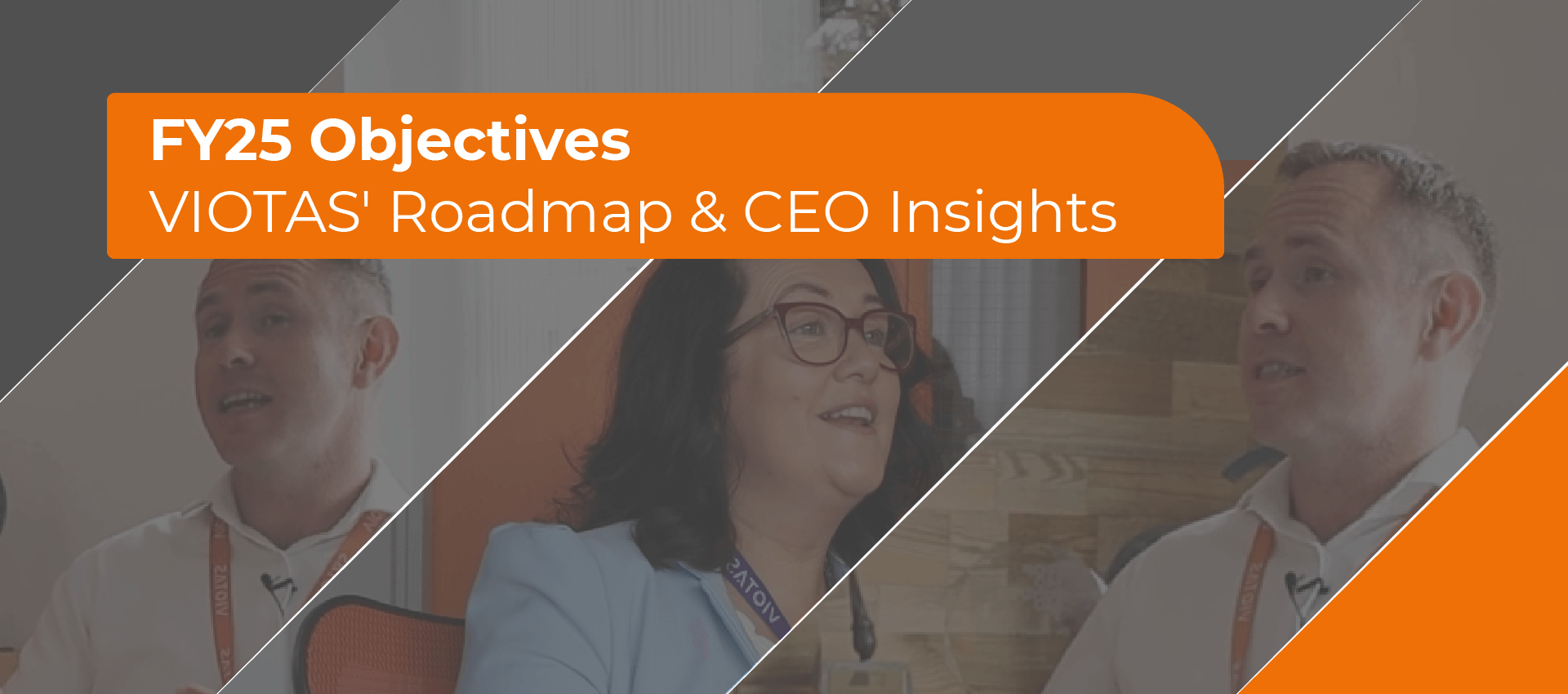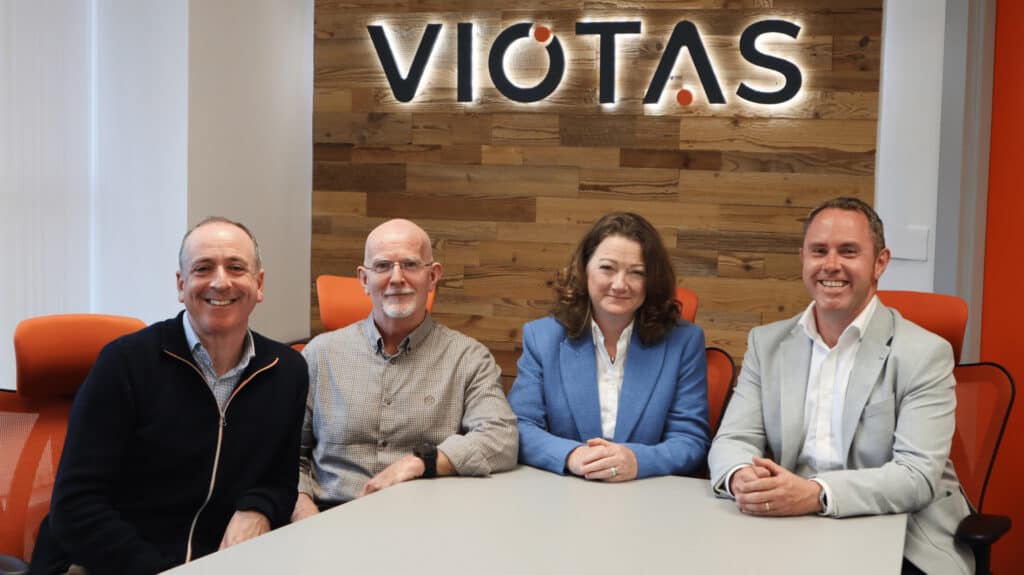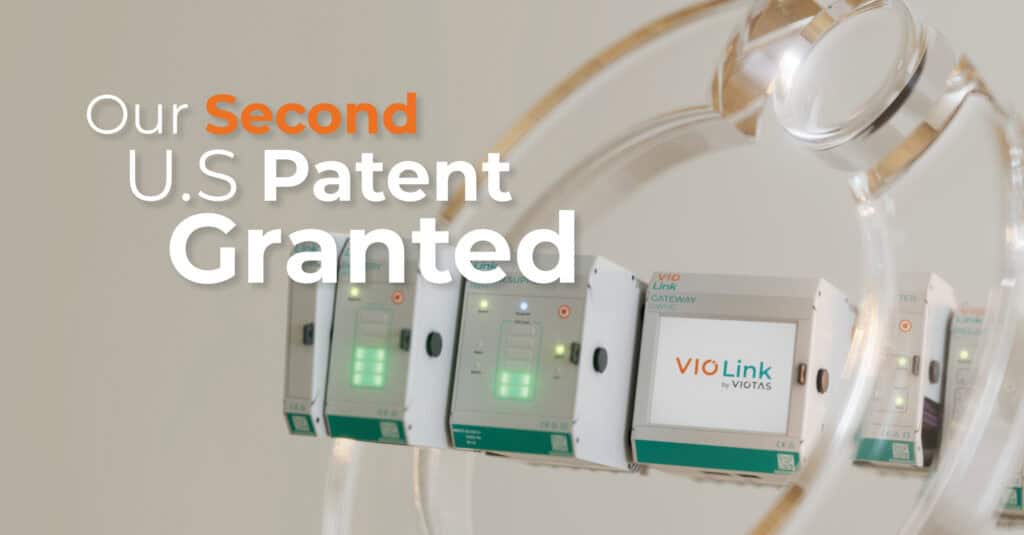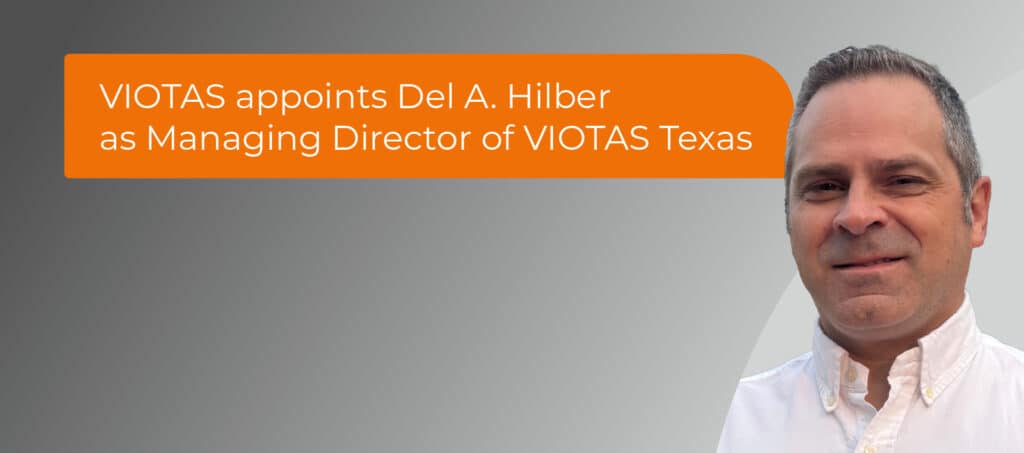
FY25 Objectives: VIOTAS’s Roadmap & CEO Insights
Following a highly successful FY24, Dr. Paddy Finn, CEO of VIOTAS, unveils our objectives for FY25, centred on Sustainability and Innovation. Sitting down with us, he emphasises how the achievements of FY24 have set a solid foundation for our ambitious goals for FY25, outlining the exciting plans we have in place and their significant impact on the industry.
Through a detailed roadmap, Paddy envisions a future where VIOTAS enhance energy efficiency, supports green initiatives and leads the change towards a more resilient and eco-friendly future.
This insightful conversation offers a comprehensive look at our goals and the steps we are taking to achieve them.
Hi, Pauline here from VIOTAS. Today, I’m sitting down with our CEO, Paddy Finn, to take us through some of the objectives for FY25. Paddy, thanks for joining me.
Pauline, thanks very much. It’s great to get the opportunity to discuss some of the plans for FY25. Of course, the team is well aware of our continued expansion into new markets, our new services, and the rapidly increasing number of clients that are joining our journey. So, it’s a really good opportunity to look under the covers of our objectives and discuss the rationale behind what we are setting out to achieve this year.
Before we get into FY25, we’ve had an exceptionally busy year here in FY24. Would you mind taking us through some of the key milestones?
Absolutely. FY24 was certainly a very busy year for everyone here at VIOTAS. We achieved several key milestones that have been in the works for a long time, laying a solid foundation for FY25 and beyond.
We continued our streak of beating budget, growing our revenue by 40%. This high-quality revenue sets us up for another year of substantial growth in FY25.
We achieved exceptional results in Ireland’s electricity market auctions, which will enable us to deliver more value to more clients in the coming years. And, in Australia, our technology made it possible for all of our clients to participate in the new very-fast frequency response service from day one of its introduction by the market operator. This meant that our clients could earn 10 times the revenue that would have been possible without our high-speed capabilities.
Finally, a major milestone was completing the management buyout of Bord na Móna as a shareholder. Duncan and I, as the original co-founders, are now the sole shareholders again, giving us greater flexibility to accelerate our growth.
The management buyout hit the headlines and was very exciting for the team. What does it mean for the business?
Bord na Móna were shareholders since 2016 and were an excellent fit for the business at the time. But over time, while Bord na Móna’s remit remained the decarbonisation of the Irish energy system, our focus shifted to international expansion, so our goals started to diverge. This was recognised by both sides. With the support of AIB and Goodbody, we executed the deal. They have come alongside us, not just to provide the financial backing for the MBO, but to be supportive partners for our accelerated growth plans going forward – through FY25 and beyond.
When you mention exceptional results in Ireland’s electricity market auctions, what does this mean for our clients?
Participation in Ireland’s electricity market is secured by auctions held years in advance. We’ve been the largest demand response provider by revenue in Ireland for some time, and in recent auctions, we secured nearly three times the revenue of our closest competitor. By securing higher auction prices, we pass through more revenue to our clients. This means our clients earn more by partnering with us. We’ve also secured 10-year contracts, providing long-term revenue streams to support investments in power generation assets like batteries and biofuel generators for our clients in Ireland.
You said our technology made it possible for our clients in Australia to benefit from more value being placed on faster response. Was this expected and what does it mean for our clients in there?
Yes, it was expected. We anticipated this trend, and it guided our technology development and market expansion plans for quite some time. You see, when electricity grids reach high levels of renewable energy, they reach a ceiling, beyond which they need high-speed response to handle large faults without relying on fossil fuel generation. Reducing the amount of fossil fuel generation needed in-turn raises this ceiling, allowing for more renewable energy to be used.
We identified Australia as the next market where this would be crucial, so we set up there in 2020. The very fast frequency response market, called R1S, launched last October, and thanks to our technology, all our clients participated from day one. This service quickly became the most valuable frequency response service in the market, by a significant margin, significantly boosting our clients’ revenue. But our technology provides responses nearly ten times faster than required, so our clients will continue to benefit as even faster and more valuable services are introduced in the market.
Coming back to our plans for FY25, are there key objectives or themes for the year ahead?
Yes, but it’s important to remember that this year is just one step on a longer-term growth path that aims to deliver over a sustained period. I say that we are building a sustainable business to deliver sustainable growth by supporting a sustainable future. So, the three pillars, or themes if you will, that underpin our near-term and long-term objectives are sustainable business, growth, and future.
It would be great to talk about how these themes translate into objectives for the coming year. On being a Sustainable Business, do you mean from an environmental perspective?
Of course, we strive to be environmentally sustainable ourselves, and our purpose as a business is to enable our clients to support the electricity grid’s sustainability. But “sustainable business” also means ensuring our team and internal systems are robust enough to deliver our growth plans. As businesses grow, their internal fabric can become threadbare, whereas maintaining a strong core can be a core strength.
You see, not only do we develop technology for our clients, we also develop the tools and systems we use internally. These are crucial for our teams to work effectively and deliver a smooth customer journey. So, this year, there will be a focus on enhancing these internal systems and the support around them, ensuring our teams have the same level of internal support we’d expect from any third-party vendor.
Also, we’re again reaching out to clients for feedback on their experience working with us and how we can deliver more value throughout our partnerships with them. We set high standards for ourselves and aim to give our clients an exceptional experience based on value generation, trust and reliability. We pride ourselves on our impeccable client retention record, and their feedback helps us continually improve and exceed expectations.
Growth is something we’ve certainly seen a lot of in recent years, but you talk specifically about Sustainable Growth. What does Sustainable Growth mean to you?
Sustainable growth has been part of our thinking from day one. VIOTAS started as a bootstrapped, self-funded company, so we had to be very commercially minded. We believe a business should deliver genuine value to generate cash, which then enables more value creation, fuelling a continuous growth cycle. Reaching profitability within three years of when we started trading was a major milestone. We subsequently reinvested our profits to fund a significant R&D program and our international expansion.
Looking ahead, sustainable growth means purposefully ensuring our growth continues to feed itself by continually creating and delivering more value streams. This cycle can accelerate as new markets begin to return dividends and we perhaps take on external investment, enabling us to keep growing by repeating this value-creation process.
How do we plan to grow this year?
Well, there is a key reason why growth is important other than for the sake of growth. You see, to deliver on our sustainable growth objectives, we need to remain resilient against potential volatility in any of our revenue streams. We do this through diversification, and this is why we operate a 3-axis growth plan – Delivering more services to more clients in more markets.
So, what markets do we expect to find ourselves in next?
We have identified Texas as being the next grid approaching a renewable energy ceiling where our high-speed demand response services can add significant value by helping to raise that ceiling. We are already building a presence there and have built relationships with some great partners, so a lot of our focus in FY25 will be on completing our technical, regulatory, and commercial readiness for go-live there, in the ERCOT market. All the while, we will continue our global suitability scans, carrying out deeper studies on high-potential markets, and building relationships in markets that we see on the horizon beyond FY25.
And how do we plan to extend our service offering this year?
In Ireland, we’ve launched our Asset Development Programme in collaboration with ESB Smart Energy Services. This leverages our 10-year capacity market contracts to fund battery storage and bio-fuel generation for clients in areas of the grid that need it most, enhancing power security for their sites and helping to support the wider grid.
In Australia, we’re expanding access to the wholesale demand response market, allowing more client types to benefit from demand response participation with VIOTAS, in addition to the frequency response market. We have also expanded our services to battery energy storage, co-generation, and solar farm operators.
It’s also about evolving our existing services. Recently, advancements in our AI Optimisers have significantly increased value and reduced market risk for us. We are working on more such enhancements in FY25.
Finally on growth, how are we planning to extend our reach to more clients this year?
In Ireland, Australia, and now Texas have ambitious targets to deliver our services to a significant number of new clients this year. We are doing this by deepening our technical knowledge of new sectors so we can find opportunities for clients that have never participated in demand response before, while also expanding the opportunities available to those that have. This is very much a collaborative effort with each of our jurisdictions sharing their sectoral knowledge with each other so they can create a rising tide across the group.
I’d like to wrap-up on your point about developing for a sustainable future. What does the future hold in store for us?
As a business, we aim to facilitate the sustainability journey by anticipating technical challenges that arise with higher levels of renewables on a power system. We then develop technologies and services that can play a role in alleviating those challenges. This includes addressing the emergence of new technologies on our power grids so that they can present opportunities rather than challenges.
Innovation is a significant part of our business, with 40% of our staff dedicated to it. There is a broad spectrum of challenges to address, so within Innovation, our Smart Grid Integration team focuses on identifying and preparing solutions for challenges where our strengths can have the most impact. We already play a role in supporting a number of large battery energy storage facilities, but we now have projects underway in the area of thermal storage which we expect to see a lot more of in the future.
Speaking of heat, the electrification of heat is a hot topic right now, and we have already integrated electrode boilers and heat pumps into our portfolio. This year we will continue to expand the ways in which we can optimise these assets, including working with electricity retailers on the development of tariffs that deliver the right pricing signals to incentivise desirable outcomes.
Sitting alongside the electrification of heat is the electrification of transport and we are engaging with EV manufacturers and charging infrastructure owner/operators to optimise our solutions for that sector.
Finally, given the increased proliferation of solar PV, we have started working with solar farms to enhance the breadth of services they can offer to the electricity system.
We are going to see a lot more of these asset types on our power systems going forward and our mission is to maximise the benefit they can deliver, to the grid and to their owners.
Paddy, thank you for these insights. We really look forward to seeing how the plans unfold in FY25 and indeed beyond. And thank you for watching.



